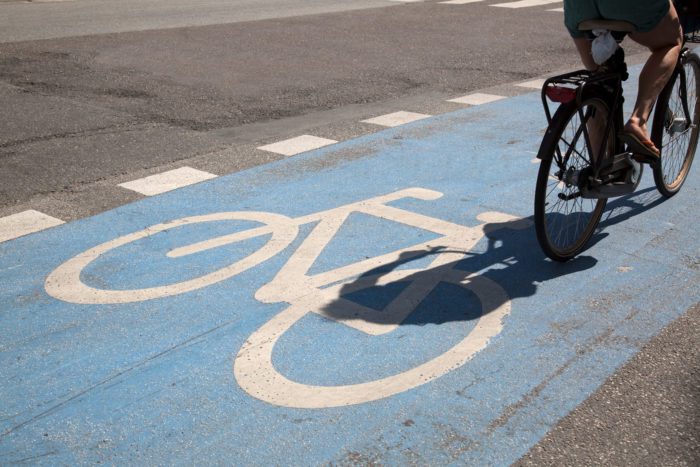
In the lead-up to COP26, and the World Health Organisation’s call for more cycling to improve health through increased physical activity and improved air quality[1], a newly-formed Active Travel Coalition is today seeking urgent action on the rollout of safe cycle routes nationwide.
The Active Travel Coalition is bringing together health, medical, environmental and cycling campaigners to call on the Irish government to show leadership on cycle infrastructure to enable families make the switch from the car to active travel modes of walking & cycling.
According to the Coalition, segregated cycle routes need to be rolled out at a faster rate than is currently the case, and need to be of a consistently high standard. The coalition says that many people want to make the switch to cycling but are put off by the lack of safe, segregated cycle routes.
The Active Travel Coalition is seeking:
- Faster rollout of the proposed high-quality ‘Safe Routes to School’ cycle path network.
- Legislation enabling trials of infrastructural changes & re-allocation of road space to enable walking & cycling.
- Commitment from local and national politicians to lead the move to greater Active Travel.
- Continued strong funding coupled with rigorous oversight for safe cycle route development.
- Creation of networks of cycle routes, not just one-off routes that don’t interconnect.
Between 1991 and 2016 walking and cycling to school in Dublin fell from 64% to 46% while the percentage being driven to school increased from 17% to 41%[2]. Dr Una May, Director of Participation and Ethics at Sport Ireland said “Sport Ireland research shows that only 1 in 3 adults and 1 in 5 children meet recommended daily physical activity levels. We know that reaching the physical activity guidelines will require a mix of sport, recreational physical activity and regular active travel. Investments in active travel infrastructure can increase cycling to school and work, helping increase the number of children and adults meeting the recommended daily physical activity levels.” Sport Ireland 2018 CSPPA and 2019 ISM studies.
According to Mark Murphy, advocacy officer with the Irish Heart Foundation, “30 minutes of moderate intensity activity, such as walking or cycling, five days a week, reduces your risk of developing heart disease and stroke, and contributes to overall improved levels of health. However, we know that if we want more people cycling, particularly school children who want to get to school by bike, but feel it may be too unsafe, we need a major expansion of safe, segregated cycling tracks”.
Clair Naughton from Diabetes Ireland said: “Having a healthy lifestyle including healthy eating, taking regular physical activity and having a weight that is appropriate for your height, is key to both the management of Diabetes and the prevention of Type 2 Diabetes and Pre-diabetes. Building physical activity into the daily commute to school and work may be one of the easiest ways of ensuring you meet the recommendations for regular physical activity”.
27% of adults who cycle to work, school or college in Dublin are female[4] compared to circa 50% in countries with good cycling infrastructure and culture (Germany, Netherlands, Denmark). Of teenagers in Dublin who cycle, only 10% are female. Only 1% of secondary school girls in Dublin cycle to school, a decline of 90% since 1986. Giulia Grigoli from ‘Women on Wheels’ says that “these figures show a major gender gap in cycling in Dublin and while the barriers to more women and girls cycling are varied, the number 1 barrier is fear of mixing with motor traffic. If we are serious about addressing this gender imbalance we need to start with safer and segregated cycle tracks”.
Ireland’s policy is to reduce Carbon emissions in 2050 by 80% on 1990 levels. Oisín Coghlan from Friends of the Earth says “transport accounts for 20% of emissions in Ireland. Given our carbon reduction targets in transport, a modal shift away from the private car is needed towards sustainable modes. Segregated cycle tracks, particularly in Dublin, are urgently needed to support this”.
Dr Sean Owens from the Irish College of General Practitioners says “the strongest evidence for reduced incidence of diabetes, obesity & cardiovascular disease is lifestyle measures centred around physical activity and healthy diets. Getting our patients, our families and our staff on their bikes for pleasure, or for a commute, is a triple win; better health for patients and families, better for the environment and better value for the public purse”.
Research from the National Transport authority shows that 11% of adults cycle daily in Dublin but 46% would like to cycle or cycle more if they felt safer[5]. Dublin Cycling Campaign’s David Timoney says that we know from the research and from the cycle traffic on the Grand Canal and Dun Laoghaire & Seapoint cycle tracks that segregated routes encourage people of all ages and abilities to cycle.”
Colm Ryder from Cyclist.ie and the Rural Cycling Collective adds that “In many areas developing cycle infrastructure will require a re-allocation of road space from the motor vehicle to active travel. We need to adapt our private car use to achieve the critical goals of an improved and safer public realm and more efficient movement of people around our towns, cities and rural areas“.
For more information on why cycling tracks are so important, click here.
The Active Travel Coalition consist of the following organisations:

[1] https://www.euro.who.int/en/health-topics/environment-and-health/Transport-and-health/news/news/2021/6/promoting-cycling-can-save-lives-and-advance-health-across-europe-through-improved-air-quality-and-increased-physical-activity
[2] www.cso.ie
[3] Sport Ireland 2018 CSPPA and 2019 ISM studies.
[4] www.cso.ie (2016 census)
[5] www.nationaltransport.ie/bike-life-2019-dublin-metropolitan-area
